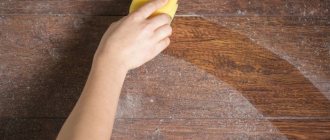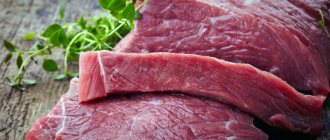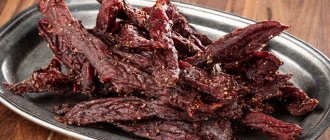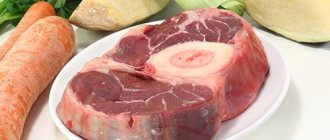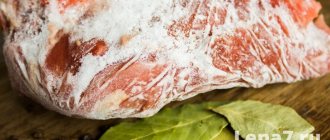Welcome, dear readers, to our website!
Here you can find out many interesting and incendiary stories, many facts and explanations about the world. On our website you will find a lot of useful and interesting information from various fields of science, sports, nature, animals and much more. Read and share with friends!
In this article we will find out why foam forms when cooking meat.
Having placed a piece of meat in a pan of water and turned on the burner, hoping to cook a delicious soup or broth, the housewife may notice foam rising when boiling. There may be more or less, but this foam appears in almost any case. What do bubbles form from? Do they need to be removed, or is it better to leave them?
It is not difficult to answer such questions - the composition of the foam is known, chefs have their own useful recommendations for preparing first courses of meat.
Composition of foam appearing in broth
Meat is a protein product; it also contains fats and bone particles. During cooking, the main part of the proteins remains inside the piece, but a small volume of them is released into the water and coagulates under the influence of high temperatures, forming foam.
The foam during cooking is the protein released from the meat . In this case, it has a light, grayish tint. This foam can be left; it will disperse on its own during the cooking process, although the broth may not become too transparent.
Interesting fact : if you accidentally break an egg during the cooking process, when immersed in water, a similar foam may also arise. It is also created by cooking legumes. Beans and peas are rich in protein, which can also be released into the water, creating a light foam.
Be carefull! If a large amount of foam forms when cooking soup...
Usually we pour cold water over the meat and, waiting for it to boil, immediately begin to skim off the foam.
The foam on the surface of the broth is nothing more than coagulated protein. When heated in cold water, dissolved proteins and mineral salts pass into the water, and when meat is placed in boiling water, they remain mainly in the meat itself.
If you cook meat without needing a rich broth, then put it in boiling water; in order to get a good broth, start cooking by placing the meat in cold water. Do not rush to skim off the foam - they have nutritional value and are necessary for the benefit of the broth. By the way, so that the flakes of foam do not tempt you, throw a head of onion into the pan - the white will curl and the foam will stop rising.
You also need to pay attention that the foam can be white (this is the case as described above) and dark. So, it’s dark blood, and it’s up to you to decide whether it’s worth removing the dark foam.
And a few more tricks when preparing soup: If you accidentally oversalted the broth, put a handful of rice wrapped in cheesecloth into it. It must be remembered that if you cook the meat over high heat, it will be more tasty than the broth, and if you cook it over low heat, the broth will be tastier. Rassolnik can be cooked in meat, fish and mushroom broths.
You need to add salt to the meat broth half an hour before the meat is ready, fish broth at the beginning of cooking, and mushroom broth a few minutes before it is ready. If the foam in the broth has sunk to the bottom, you need to add a glass of cold water to it, and after the foam rises, remove it. Remember that cold water worsens the taste of the broth, but boiling water does not. Coloring the broth with a decoction of onion peels also increases its nutritional value. The taste of the meat broth will improve if you add crushed garlic to it at the end of cooking. After the soup is cooked, remove the bay leaf from it. Before straining the fish broth, let it sit for 20 minutes. If you add sauteed flour to the soup, it will turn out thicker and vitamin C will not be destroyed.
Did you like the article? Subscribe to the channel to stay up to date with the most interesting materials
Source
To skim or not to skim the foam in the broth?
Some housewives still prefer to remove the foam, despite its protein composition. Removal is carried out not only for aesthetic reasons. A gray, dark brown mass is formed from blood when it is contained in a carcass or piece of meat.
It is advisable to remove it; coagulated blood has a specific taste that not everyone likes. Although it is not harmful.
Sometimes bone marrow, tiny particles of bone, even small debris come out into the foam if the piece was poorly washed before cooking. It is better to remove such foam immediately. If there are contaminants in the meat, it makes sense to do more than just rinse the product before cooking.
You can boil water with meat, then drain it and put it back to boil in fresh water. The result will be positive.
Meat of dubious origin, which could be stored for a long time or subjected to chemical treatment, “pumping”, is also first boiled, then boiled in new water, the foam must be removed.
Is it necessary to remove the foam?
The dish tends to turn sour very quickly. The foam itself consists of the first coagulated proteins. For denaturation, 40 minutes is enough for them.
In addition to the fact that they cook quickly, such proteins can sour very quickly. If there is foam in a dish, it may disappear the very next day.
Foam can add bitterness and an unpleasant odor to the dish. This particular scent is not liked by many people. If there is an admixture of blood in the foam, it will even be slightly bitter. From this we can conclude that foam does not have the best effect on the taste of the dish.
A dish with foam looks ugly. After all, experienced cooks always strive for the broth to be as clear as possible. To do this, you not only need to remove the foam, but also strain the broth through cheesecloth. Professionals say that the first dish should be as transparent as possible so that all the ingredients are completely visible. Then the broth will look very beautiful and aesthetically pleasing.
Author: Veronika Golasovskaya
How to get rid of foam in broth?
A large amount of foam does not look aesthetically pleasing; many housewives try to get rid of it. It is not necessary to scoop out the liquid; you can simply throw onions into the broth, which will stop the process of its release. The quality of the meat also plays a big role.
Young veal will produce less foam than beef. A product that has not undergone chemical treatment, which does not contain contaminants or blood, also creates fewer problems during preparation than an old, low-quality one. Choosing the right piece at the stage of purchasing products will eliminate the release of a large volume of foam that will have to be removed.
If you rely on the protein to dissolve on its own and the bubbles to disappear naturally, you need to wait about 20 minutes.
During this time, the processes will stabilize, and only a light trace of yellow fat will remain on the surface. If there is a large volume of foam, the broth may become cloudy, and when it cools, some sediment may be found in it - there is no need to worry, the quality of the broth remains normal. A small amount of released protein will not affect transparency or color.
The protein that is boiled down is just as beneficial as the protein that remains in the meat. The main thing is that it is the protein that comes out that will saturate the broth and increase nutritional value, and not harmful substances or chemicals.
Opinions differ regarding whether it is worth leaving the foam in the soup. Some housewives do not pay attention to it, because the bubbles disappear on their own by the time it comes time to add other products needed to prepare the soup into the pan. Others specifically wait for it to come out in order to remove it completely, to make sure that it does not come out again.
Still others react to this phenomenon according to the situation, removing the dark foam or removing it when the quality of the meat is questionable, and leaving it when everything is in order. There is no clear, stable advice on this matter; each person has the right to act according to his own taste, according to established habits. After all, today is not the time when you have to fight for every gram of protein in order to survive, and you can quite afford the luxury of removing a small amount of useful substances for the sake of aesthetic pleasure from a clear broth without suspensions or turbidity.
How to reduce the amount of foam that forms when cooking broth
To prevent the appearance of foam in the broth from being critical, follow simple rules.
- Place raw meat not in cold, but in boiling water. When heated quickly, the protein will curl almost immediately inside the piece and will not have time to get out.
- During the cooking stage, shortly before the foam forms, add a peeled onion, whole or cut in half, into the broth. Protein flakes will stick to it. At the same time, the broth will become more flavorful.
Add an onion to cooking meat to reduce foaming
- A raw egg, beaten into the broth after the formation of protein foam, acts on the same principle as an onion.
- Pay attention to the quality of the meat. If it is young, there will be much less foam from it than from an old one. And, of course, wash meat thoroughly, even homemade meat.
How to make sure there is no foam?
When cooking meat, a lot of foam often forms, and you have to remove it more than once, especially if the water boils slowly. To do this, use a slotted spoon or a regular spoon. But there are secrets that will help reduce the formation of foam to nothing.
- Place the onion. The onion head will stop the denaturation process. The protein will curdle and the foam cap will no longer rise.
- Throw the meat into boiling water. In this case, it seems to be sealed, and the protein practically does not get into the water. But keep in mind that the broth will be less rich. But the meat itself will be as healthy and tasty as possible.
If foam particles remain and sink to the bottom, add a glass of ice water to the boiling broth. It will lift the cereal to the top. You can also get rid of the foam by straining through cheesecloth. You just need to let the broth sit for 15–20 minutes.
The covenant to skim off the foam while preparing broth is passed down from generation to generation. Many people argue that it contains all the harm. However, this is not quite true. It is removed due to its unaesthetic appearance, specific taste and smell. But in general it is not dangerous to health. The foam that forms when cooking meat is just coagulated proteins.
Source
How to determine what kind of meat it is?
How to distinguish the meat of different types of animals, poultry and game?
- BEEF. ...
- Bull meat is dark red with a bluish tint, dense, rough. ...
- The meat of a fattened ox is dark red, tender, and dense. ...
- Cow meat is intensely red in color (the color of ripe raspberries), less dense than ox meat.
Aug 8
2009 Interesting materials:
How long does it take to solve a Rubik's cube? How long does it take to humidify a room? How long should you keep the heating pad on? How long should you keep yogurt in the yogurt maker? How long does it take to build a house? How long does it take to create a game? How long does it take to bake chicken? How long does it take to cook fish? How long should you wear a hair mask? How long should invoices be kept?
What's going on with the kettle?
The rate of formation of a layer of solid deposits depends on the following factors:
- concentrations of chemical compounds in water;
- heating frequency;
- the quality of the surface of the walls, and in the electric kettle - the heating element. By the way, it is quite possible to remove it in an electric kettle at home, spending no more than half an hour.
When purchasing a new kettle, the process of scale accumulation will be slow, but will accelerate after using incorrect methods for cleaning kitchenware. These include mechanical impact with metal sponges and aggressive chemicals.
By damaging the surface, small defects are formed, into the cracks of which scale gets trapped and it becomes increasingly difficult to remove.
Why is scale in a kettle dangerous? Disadvantages of scale formation:
- Low coefficient of thermal conductivity and, as a result, more electricity (gas) is consumed to heat or maintain the desired temperature;
- Deformation. A deep layer of deposits, if you try to get rid of it, can damage the surface of the device.
Working in this mode, the household appliance will quickly fail.
As for methods of dealing with unpleasant deposits, valuable knowledge of chemistry again comes to the rescue. The problem is that science was taught in school without drawing parallels with real life.
From an everyday point of view, the chain is as follows: “scale = carbonates (insoluble salts)” - “carbonates + acid = soluble salt + carbon dioxide in a gaseous state.” In the case of a kettle, the acid must be organic. Lemon and vinegar are considered the most effective. If you choose between them, it is worth noting that cleaning with citric acid is a little easier, and you will also get rid of the smell. Although vinegar against scale has a number of its own advantages.
Is it necessary to remove foam and why?
Curdled protein will not cause any harm to health. The only reason it is removed from the pan is because it looks unsightly. As soon as the water boils, the foam turns into unpleasant-looking flakes of varying sizes that are not so easy to catch. The broth becomes dark and cloudy. Therefore, the foam is removed immediately when it appears, before the water boils.
It is better to remove the dark, brown foam formed from the blood in the meat. Although it is no more harmful than regular blood, clotted blood has a specific taste that not everyone will like.
If the meat is fresh and clean, it is not necessary to remove the foam when cooking it.
It is imperative to remove foam contaminated with small particles of bone or debris from poorly washed meat. If you are in doubt about the origin of the meat (for example, it has been stored for a long time or, perhaps, has been chemically processed), it is better to do the following: wait until the broth boils, without removing the foam, and drain it. Pour fresh water over the meat and cook again.
The foam can be removed with a tablespoon or a slotted spoon. But it is most convenient to do this with a fine sieve for sifting flour. It perfectly passes clean broth and retains everything unnecessary.
These sieves for sifting flour will allow you to clear the broth from foam
Thawing meat
Meat must be thawed slowly in whole carcasses, half carcasses or large parts. When the meat slowly thaws, the meat juice formed when the ice crystals melt has time to be absorbed into the muscle fibers. As a result of this, the meat almost completely restores its properties. Frozen meat, thawed at a temperature of 3-8°C for 1-3 days, depending on the type and size of the pieces, is almost no different from chilled meat.
Rapid thawing of meat should be resorted to only as a last resort, in the absence of the necessary conditions for its slow thawing or in the event that the meat must be sold immediately. In catering establishments, rapid thawing of meat is carried out in a meat preparation or hot shop at a temperature of 18-20°C. The meat is hung on hooks or placed in baths, on tables and left for 10-24 hours, depending on the size of the pieces. The released meat juice is collected in a special container. When meat quickly thaws, the muscle fibers do not have time to completely absorb the released meat juice. As a result, some of the nutrients are lost and the meat does not restore its original properties. After heat treatment, such meat turns out to be less juicy and tasty than slowly thawed meat.
What does it mean if a lot of foam forms when cooking broth? Cook your meat wisely!
When we put meat to cook for broth, we first fill it with cold water, and when it boils, we immediately skim off the gray foam. This film on the surface is actually nothing more than coagulated protein.
When a piece of meat is heated in cold water, the proteins and salts it contains are released into the water. When we send a piece of meat straight into boiling water, these substances remain in the product itself.
If you do not need a rich broth, then cook the meat immediately in boiling water. But if you want to get a rich broth, then you should put the meat in cold water. Our advice to you: do not rush to remove the resulting foam - in fact, it contains many useful and valuable substances. And to reduce foaming, try adding a small onion to the pan. The onion helps the protein coagulate and prevent the foam from rising in large flakes.
Pay attention to the color of the foam in your broth. We described above what to do with white foam. And the dark foam is coagulated blood, and only you can decide whether to remove it or not.
Here are a few more secrets that will help you when preparing broth:
1. If you have added too much salt to the broth, place a bag of rice in it: it will absorb the excess salt.
2. If you want to cook delicious meat, put it on high heat. On low heat, on the contrary, the meat will turn out less tasty than the broth.
3. If you want to prepare pickle soup, you can cook it with equal success in meat, fish or mushroom broth.
So what is foam?
According to some experts, all the harmful substances contained in this product get into the scum on the brewed meat. Therefore, you should definitely get rid of it. Others argue that the foam is just an ordinary protein that has coagulated under the influence of heat, which is nothing harmful to health, and there is no need to worry about whether or not to remove it from the surface of the soup.
The work is difficult, but generous: the salary of Prince Harry and Meghan's security guards is known
How to make a cute children's bench with a toy storage box: master class
“We have something to eat”: Koroleva told how she and her husband joked about her
Why does foam form?
The foamy cap that covers the broth in the pan does not look very appetizing. But these are definitely not pollution or harmful substances. All meat and poultry contain a lot of protein. And foam is coagulated protein. During cooking, coagulation occurs, and as a result, foam forms on the surface of the water.
The slower the heating, the more proteins are released. Accordingly, a lot of foam appears. Increases its amount in blood. In this case, the foam cap also changes color - it turns brown.
The quality of the meat and its purity matter. Young veal produces less foam than beef.
How to remove foam quickly and without fuss?
You can use a special spoon - a slotted spoon. It looks just like a regular one, but is equipped with holes through which the broth is filtered, after which the flakes settle on the surface of the spoon. Some housewives throw an onion into the broth. The protein sticks to it and does not spoil the beauty of the dish. You can also add fried carrots and onions to the brew. This method is acceptable for those who are not afraid to make the soup more fatty.
But my mother uses a completely radical remedy. She strains the broth through a special thick cheesecloth, not at all afraid of the prospect of washing another additional pan after cooking.
Found a violation? Report content
Why does foam rise?
If there are no impurities in the water that contribute to the creation of bubbles, then the creation of foam
may be caused by water movement.
… If water moves, it begins to foam. Due to the rolling waves, the air masses between them turn into water and bubbles form. They rise
to the top and create
foam
.
Interesting materials:
How is cubic m calculated? How is a young specialist considered? How is personal income tax calculated for individual entrepreneurs? How is royalty calculated? How do you count major repairs? How are heating charges calculated? How are social contributions calculated? How are daily allowances calculated? How to calculate penalties at the key rate? How to calculate the area of a balcony?

